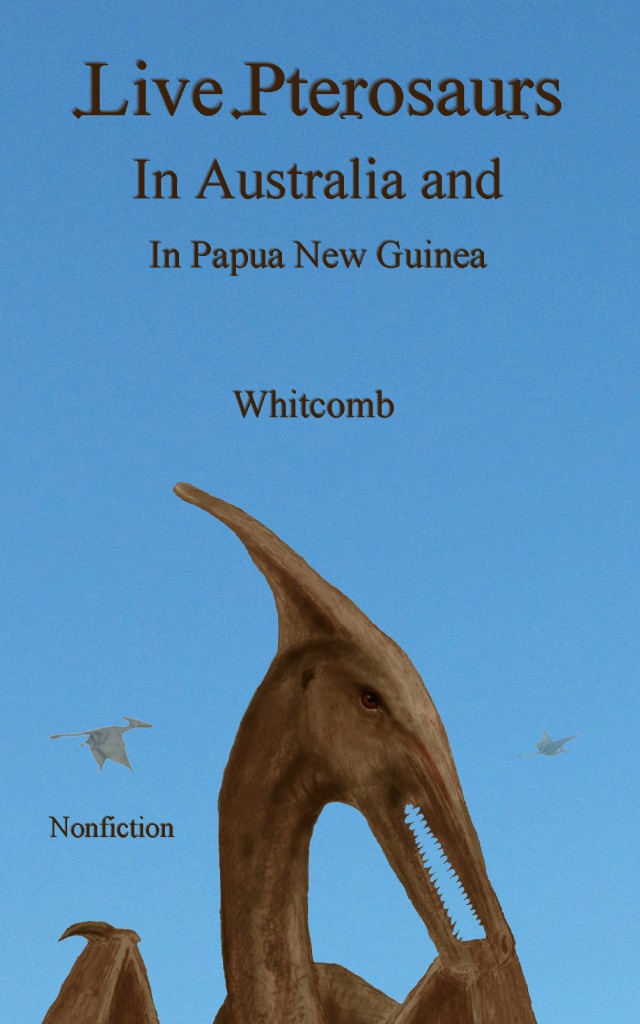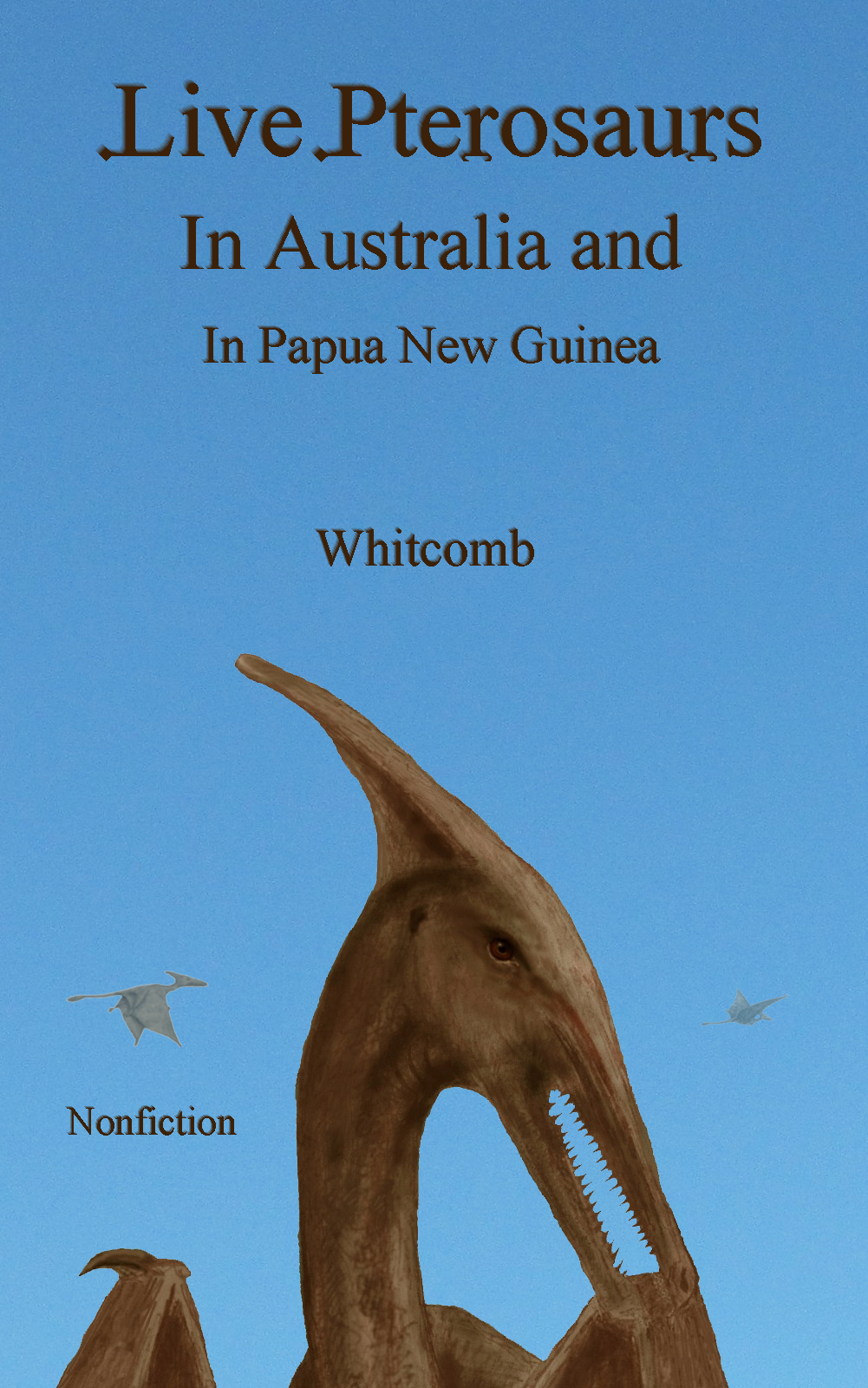I don’t usually make a lengthy post, in this blog, on a negative review of one of my books (the book now in question is Live Pterosaurs in Australia and in Papua New Guinea, Kindle ebook, by Jonathan Whitcomb). But the recent Amazon review by “WS” deserves a response for much of it is patently false and much is distorted or misleading. Here’s a screen shot of the review:
.
.
“More religion than investigation”?
Perhaps 1% of the book mentions two missionaries (one in Africa and another in Papua New Guinea) and a few creationist explorers and how the Biblical creationist perspective made it easier for them to search for living pterosaurs. But that 1% of the book gives no details about any religious beliefs nor does it promote any religion of those men. Their involvement is just a matter of record.
Live Pterosaurs in Australia and in Papua New Guinea (LPAPNG) does give many details about sightings of apparent pterosaurs and expeditions to search for the flying creatures and interview eyewitnesses. It also investigates why it is so difficult for Australians to report their encounters. Why doubt that LPAPNG is a cryptozoology book or believe it is “more religion than investigation?” Perhaps WS allows only skeptical investigators to count and considers creationist investigators to be incapable of any genuine investigation. But why does WS not give any details or explain what is meant by the title “More religion than investigation?”
“One or two Intriguing Reports”?
Of the many pterosaur sighting reports investigated in this Kindle book, four of them are labeled “key” sightings. Each of those four is given a chapter of its own:
- “The Finschhafen Pterodactyl”
- “The Bougainville Creature”
- “The Lake Pung Encounter”
- “The Perth Creature”
Consider WS’s declaration: “The book really consists of one or two intriguing reports . . .” Without the word “intriguing,” that statement is patently false. With the word, WS is declaring his opinion or his personal interest in a small portion of the sighting reports. But WS’s statement can be misleading, for no mention is made about the many sighting reports investigated in the book, the many reports that he personally does not find intriguing.
Just Vague Lights?
WS mentioned “some vague sightings of lights in the night sky” but drops the subject. Consider what WS failed mentioning:
Jonah Jim saw the creature in 2001, between 10 p.m. and 11 p.m., as it flew about 500-550 feet overhead, in the general direction of Lake Pung. The tail was glowing blue.
He estimated the size: The wingspan was six or seven meters and the tail length was three meters or a little less. . . .
Jonah Jim was shown the same pages of silhouettes shown to Jonathan Ragu. From among those thirty-four images, he chose #13, the Sordes pilosus, the same Rhamphorhynchoid pterosaur chosen by Ragu.
That nine-foot-long tail that was glowing blue, flying toward Lake Pung, about 500-550 feet high, connected to an apparent Sordes pilosus Rhamphorhynchoid pterosaur having a wingspan of about twenty feet—that does not sound vague to me. Why fail to mention that light?
“Antiscience Rhetoric”?
WS said that much of the book contains “the author’s antiscience rhetoric.” If that were the case, it would be easy to find some of it to quote. Let’s examine some of what the book actually contains:
The first discovery of a pterosaur fossil by a Western scientist, in 1784, was decades before Charles Darwin began writing about his ideas on extinctions and evolution. Before Darwin, Western scientists had assumed that all species of pterosaurs were extinct for a simple reason: Those who discovered the fossils had no experience with any similar animal that was living.
Also important, probably no scientist at that time had considered that a few species of pterosaurs might still be alive, rarely seen because they’re both uncommon and nocturnal. Today, some cryptozoologists believe that one or more of their species are indeed uncommon and nocturnal—and still alive. [from early in the first chapter]
Does the above sound like “antiscience rhetoric?” What’s wrong with considering the possibility that a few scientists in the late eighteenth century and early nineteenth century might not be 100% correct about universal pterosaur extinction?
For “ancient” creatures assumed extinct, post-Darwin scientists were incapable of accepting anything short of an official scientific discovery. But nothing happened. How could living pterosaurs remain hidden, considering all the various scientific discoveries in the twentieth century? It was simple. The uncommon nocturnal flying creatures found it easy to remain hidden: Nobody was looking for them. [from the middle of the first chapter]
Where is the “antiscience rhetoric” in the above paragraph? What is unscientific about the idea that scientists after Darwin were not looking for living pterosaurs?
By the middle of the twentieth century, school teachings had cemented the ancient-extinction idea into Western culture, so dinosaurs and pterosaurs were portrayed as living only in science fiction and dragons only in fantasy. [further into chapter one]
Do you notice any “antiscience rhetoric” in the above sentence? I see nothing unscientific in the statement.
Assumptions About Extinctions
It seems to me that WS became upset that my book appeared threatening to the credibility of generations of assumptions about extinctions. I suggest we take an open mind to the definition of “science” rather than think it equates with such a narrow point of view as the universal extinction of all species of pterosaurs.
###
More Religion than Investigation?
This dismantles criticisms, by WS, of the cryptozoology book Live Pterosaurs in Australia and in Papua New Guinea.
.

Non-fiction cryptozoology book Live Pterosaurs in Australia and in Papua New Guinea
From the end of the book:
What dictionary defines “pterosaur” without the word “extinct?” There lies the first problem, in Western society, for Australians and Americans are raised from young childhood to believe in the extinction of all species of pterosaurs and dinosaurs, without compromise, and what is the explanation? “Science.”




